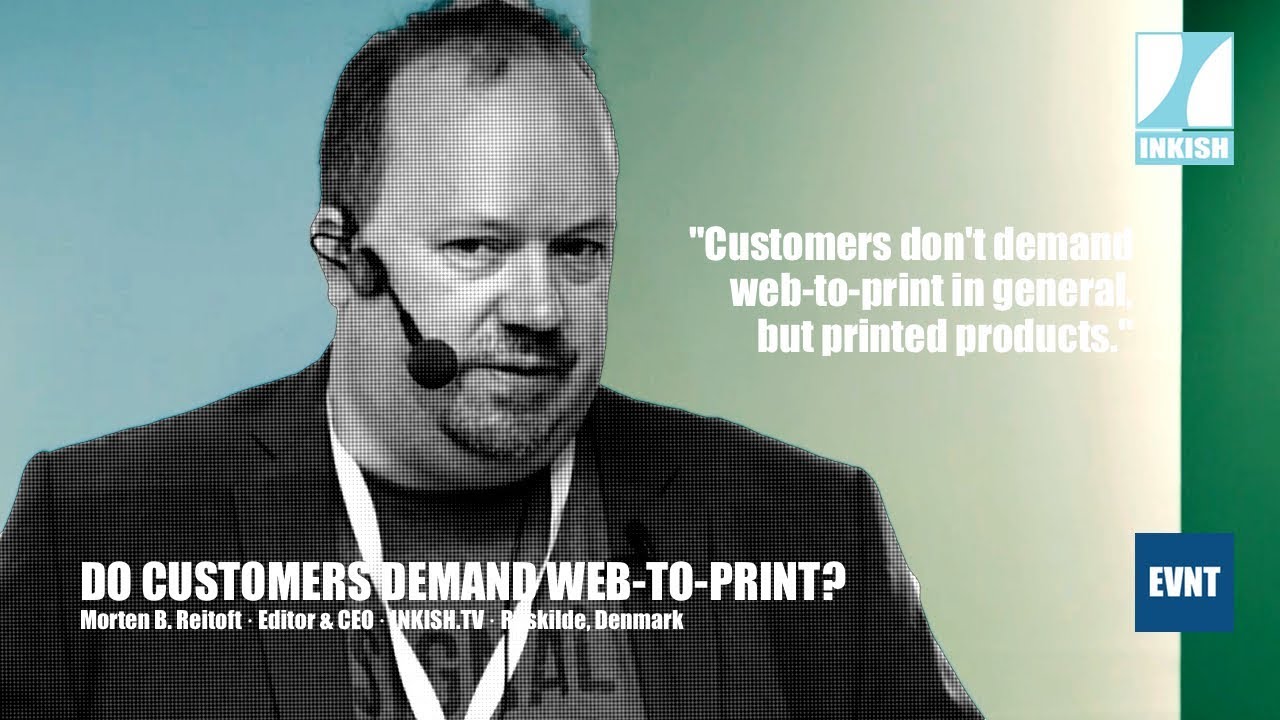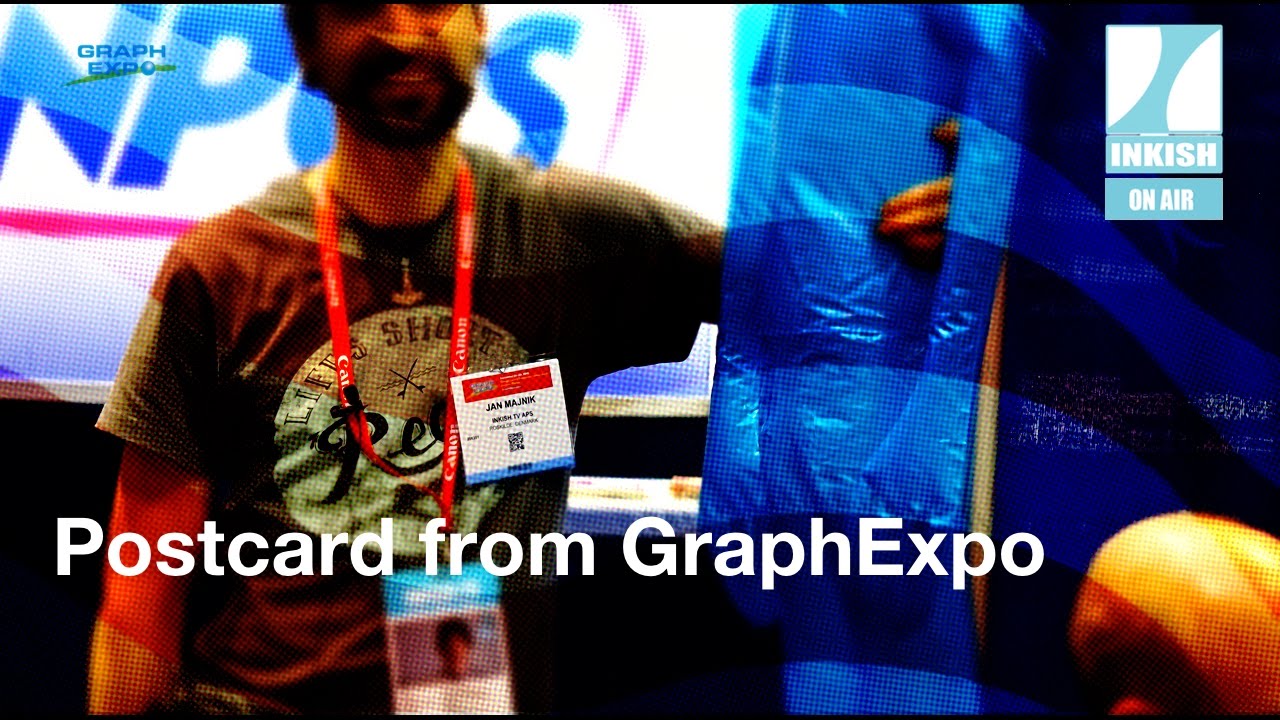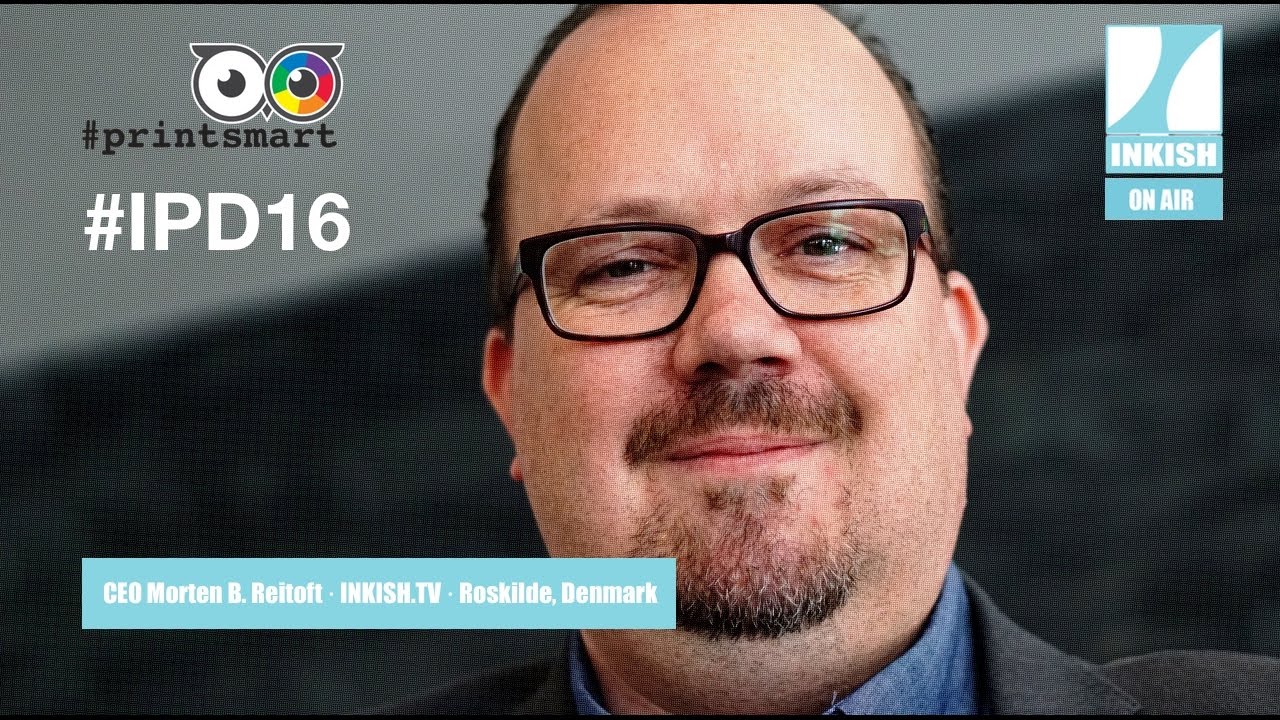The Mystery of Prices by INKISH.TV editor Morten B. Reitoft
Editor Morten B. Reitoft from INKISH.TV was invited to Grafkom I/O to give a speech about “The Mystery of Prices” and though both sound and image quality isn’t that good, we have decided to publish this anyway as a separate episode on INKISH.TV.
The speech touches upon cost, market, and sales prices and why pricing is a mystery to some. One of the reasons is of course because all printers don’t win all jobs and you can then speculate about your customer’s loyalty, total market potential and other things in your pursuit of success.
My name is Morten. We have made this little brochure here on business cards. And, I want to give it to you. The paper is sponsored by Antalis. It’s quite expensive paper. Every sheet is different paper. It’s a 14-color offset printed work with spot varnish, so take a look at it. Everything here and I know that we have not been talking so much about it, but everything here is about paper, and print, and making money, and making our customers convinced that the printed media still have a future.
So, when we did this one, that was for an exhibition Sign & Print in Denmark. And, we did this because remember that everytime you go somewhere on an exhibition, you may collect a lot of printed products. And after, maybe you will trash that one, because it’s too big basically, right? You may think that from a professional perspective that it’s well done. You may not like the design. You may not like the paper. But, from a professional perspective, I’m quite sure that you can appreciate both time and money and effort into doing that kind of job. And, we did that for maybe one of the most obsolete printed products in the industry, the business card.
Who here produce business cards? Everybody, right? Who produce business cards in offset printing? One. Okay. Who sells 200 business cards for 3,000 kroner? I do. I sell approximately – I am from a 3-person company. This is a – just turn it around. You can take one if you want to. We sell about between 60 and 70,000 Kroner worth of business cards a month in a price range of 3,000 Kroner for 250-300 business cards. We also sell 250 business cards for 149 Kroner. We do both, right. So, just something to think about, because we are going to talk about prices. I don’t know anything about prices. I have to apologize for that, because when I said to Ola I wanted to talk about prices, he thought that I maybe have something wise to say. That was an error or a mistake. Big one, right? So, what I want to talk to you about is much more generic terms about pricing. Because, how many off you have an MIS system here for calculating prices? So, when you do calculating prices, you get a cost base basically, right? How many of you take your cost base and mark up the price in order to get a suggested selling price? One. Two. I can tell you in Denmark, it’s maybe 90% of the printers that do it that way, I would say.
So, this is me from a garden when it was still nice. I’m the father to three: 23, 12 and 10. And then, I’m married to Nina, but I didn’t dare to write her age in this little presentation, so forget about that. And, I promised to talk about the mystery of pricing: cost prices, market prices, sales prices. But, there is no mystery. That is basically, there’s a lot of logic in it, there’s a lot of emotions in it, there’s a lot of things where maybe we feel that we are squeezed by the customers, but maybe we are most squeezed by ourselves. Maybe we are more squeezed by technology. Maybe we are more squeezed by whatever. We are afraid of getting enough revenue for the next VAT, for the next salary, for the next whatever, right? So, why is it that to some prices is a mystery? This is not conclusive. I’m just trying to give a few punchlines. It’s because, I mean, I used to work as a sales manager in one of Denmark’s largest printing companies. And, I think we had like three people that were doing the calculations. So, the sales person could just come and, I got a customer who wants this, and then they were calculating the prices. And, I will share a secret with you. I will not reveal the name of the printing company. You can look at my LinkedIn info for that one, right? But, we didn’t win all the quotes we gave. Maybe you do that in Sweden. Do you? No. No.
So, one of the reasons why there is a mystery when it comes to this pricing thing is because we spend a lot of energy, we spend a lot of time to make offers that we believe are good and solid and good quality, and everything in the process. And you know, it’s so strange to some extent, because when we do this, all the prices, we have actually already made the production plan for our equipment. We have made how much paper we have to buy, how much waste we’re going to have. So, we have made an entire process for finding out at least the cost price, right? So, since we don’t sell all the quotes we give, there might be an issue that we have to talk about. And, the other thing is that nobody knows how many of the quotes actually turns into revenue. Because, if you lose a job, if you give an offer and you customer don’t accept it, you may not know whether they actually went to one of your competitors to – You don’t even know if they just used the price for a budget mark that was too expensive enough for them to do that. You have spent the resources in calculating. You spent your resources in actually giving the quote to the customer. You expect some kind of feedback, right? Sometimes we give a call and say, ‘Hey, did you get my?’ ‘Yes. I didn’t have time to look into it.’ That could be one answer, right? Nobody maybe really know our customer’s potential, because when we look at the pricing and the quotes we give, how many – I mean, if we look at the total here. Let’s say that all of us has given 10 quotes a day. That is about 1,500 quotes. How many of these quotes in total turn into some kind of revenue? We don’t know. We don’t know how many is asked. I know that somebody believes that they have really loyal customer. Well, that is my second last statement is that, we don’t even know if our customers are loyal. Right? And, should they be? Should they be loyal or should it be so that they take the offer that is best because that is better for their business? Question.
And, the reason why mystery of prices is interesting again is if everybody in the printing industry, as we did in the 70s and 80s, and maybe in the beginning of the 90s, was just seeing an increase in the revenue and have a reasonable profit on what we were doing, then we may not be so focused on pricing because business is doing well, business is doing great, and we are seeing something that is good enough. But, it’s not like that right now. Most printing companies, or at least the industry in total, see a decrease in revenue. American study says that over the past 10 years, the revenue in the printing business has fallen 25%, and they expect it to fall further 25% over the next 10 years. So, we have to focus on something like that. Agree or stupid? So, my claim is that most printers, they use the MIS system or an Excel or ArifiQ or Omikai or whatever, to calculate the cost base. Take the cost base then we know the price of the printing. And then, we are ad 30%. – We go online and see what our competitors are enforcing their prices on their products. And, that is a kind of a strange situation because first of all, if we are to calculate the price based on the cost base, you know as well as I do that the depreciation of the equipment, the hourly rate of the printing machine, it’s based on whether we use it 70, 80% or 90% of the potential. So, none of us is actually giving prices based on actual facts. It’s based on actually what we believe.
So, how big is the difference? Have you heard about momondo? Momondo is a website where you put in where you want to go i.e. from Stockholm to New York. You key in the time you want to go, then you get the list of the airplanes. I mean, if you don’t use this kind of website, then you use a similar one, right? I mean, right? Good. And, you like it, right? Because it makes transparency. You can select, -‘Okay, 24 hours to go to New York.’ That’s a long ride even though it’s 1,995 for a return ticket. So, what do you think of this one? It gives you the same output. It just compares about a 100 German online printing companies. So, when you want to have a business card, which is now visitenkarten. We get a list on prices that are at least online. Do you think our customers want this? And, is that a threat to our industry? No? Nobody? To some people. Because this actually, in my opinion turns us a little bit back on, what is pricing? But, if you want to sell to these prices, you have to make your printing company ready to produce these product prices. Because, the online printers, there’s absolutely no magic in it. The only thing they do, they gang print and they optimize. So, it’s only a matter of volume, right? You can have that argument!
So, how much does print actually cost? This is not real figure. That is just some stupid figures. But, let’s say that a typical printer you have this 40% paper, and then we have some consumables, we have some labor, we have some administration, we have some depreciation, and probably a lot of other things. So, this is how in our daily life is operated with our cost base. I mean, I say that we can’t use cost prices with pricing, but of course he needs to know what the cost of our products. So, in my opinion, the cost price is not important. And, the first one is that if the market is the one that defines the price, let’s say that you have made a business card, you have pre-calculated that a cost effective price should be 2,000 Kroner for 250 business cards printed on 350 grams matte pro paper, 4+4, mat coated 1+1. Pretty standard, right? You will not be able to sell it for that price. So, either you have to gang print or you have to buy from others and sell it, or you just have to acknowledge that if you want to have a piece of that cake, we need to sell something with a loss. Because, the philosophy here can be said that – Okay. If you have a customer who has, let’s say 300 employees, you may have to print the business cards with a loss in order to get the Annual Report.
So, my opinion is that cost price is only an estimate based on terms of under certain conditions. First. Cost prices doesn’t say anything, and I repeat, anything, about what the customers are willing to pay. It doesn’t say anything about what kind of competitors are charging. And, in my opinion, cost prices is only useful to figure out expected profit. So, let’s say that you calculated the price at say a thousand Swedish Kroner, and you are able to sell if for 2,000 Kroner. Then, you can figure out that you have a profit of 1,000 Kroner. What if you calculate that you should have 2,000 Kroner in cost price, and you are able to sell it for 1,500 Kroner? Should you then not sell? How many here have sold something that has a lower price than your old calculated price? I was just about to move to Sweden. So, this is something that you might opinion, and something that – We might not have been talking about prices yet in relation to how we can achieve newer technology, because do you agree with what I’ve said so far? So, that is a real life situation that we see as part of our problems in the industry, right? We simply have too little information from what the customer is willing to pay in relation to how much it actually cost to produce the piece of output. So, that is it.
Cost price is only a number. And, that’s why sometimes I think it’s so funny because, for example if you look at – I like the people from ArifiQ a lot. I know it’s a great Swedish company too, but what I really like is that you can calculate the price in a second. They quote price and they give it. They’re giving a cost price based on the same parameters I gave you just seconds ago with the market. That’s what they do. Does anybody right here have ArifiQ? Nobody. They have been pretty successful, I think. I don’t know, but I think they can be pretty successful. And, to think there are people like, rather than having complex ERP systems where you have a lot of numbers in the pre-production work you write before you actually get the same thing as ArifiQ gives you. Then, it’s so much easier if you could just write, ‘I want the 16 pages mat coated paper 4+4 and then, you get the price right away. People like that. It’s actually sale people who have estimators, who use MIS systems. It’s completely a waste of time. They know it, because when they go to the market, they can’t sell always for the price that the MIS system is giving them.
So, some of the things that we’ve been talking about, at least in Denmark, is that is there something called a the market price. And, what is the relationship between market price and selling price? And, I in my opinion and it might be a biased opinion. The market price, there is no single market price. The market price is your price, and your price is the sales price. The question is, how can you make a profit? That is the main question. Right? Nobody can sell over the market price. Think about it. If we can go to druckpreiss.de, and all our customers do that every day, and they could see that the price of the product had lost 500 Kroner for 1,000 pieces, whatever. If they have been there, and they’ve seen that price, would you be able to sell the same product for 1,500 Kroner? That would be difficult, right? And, in case you were able to do that, then you should have some extra added value. Question. Can you add service to it? Can they convince the customer that they have a better product? Can we give the customer the service and the support, and maybe a design, in order to justify the higher price? If we’re able to do that, then the customer might accept that price point. So, is the market price 500 or 1,500? Well, in my opinion is that the market price is the price the customers are willing to pay. So, we’re not competing if we are always trying to just compete on the lowest denominator. So, we say that, ‘If lasertryk.dk in Denmark, or lasertryck.se.’ I don’t know how they do marketing in Sweden, but in Denmark they say, ‘Okay. Never has print been cheaper.’ But, is that a value? I question that. That’s why I showed you that brochure. That brochure, if you take the paper price, the print price, we bought 975 pieces. Cost price for that goes 70 Kroner per piece. 70 Danish Kroner per piece. And, we know it will be trashed. Some of you may even trash it just outside here!
Did you see the business cards? Did you like them? I mean, they are pretty cool, right? They come from a – The first one, the one with the silver edge that I gave you, that is a foiled edge made by a company a called ‘Dakabo’ in Denmark. It’s a 3-person company. That’s one of the first film’s we did on INKISH. She has been elected three years in a row as the world’s best bookbinder – hand bookbinder. So, can we sell a lot of business cards in this price range?? No. Can we sell a few? Yes. And, the more that customers are buying the commodity product, the bigger the non-commodity market is. That is a mega-trend has been here for at least seven years. So, my claim is that if everybody is just following the way that online printers, lasertryk, Print24 or what the name of all the others are – and try to go that direction, then you can have all these products. If you can’t make volume on low-cost products, the only way you can make money is to go the other way and sell speciality products instead. You make products exclusive, and making it back to the handwork and craftsmanship. So, you have to thrive in the products, and convince customers that actually the value of the business card, like that one, has a higher value. In my opinion, I spent 70 Kroner on that brochure. I spent 25,000 Kroner on a small booth on Sign & Print. I know that also if you go out, and maybe have a phone, send out a representative to the market the cost may end costing you 2,000-3,000 kroner? – Hotel, Your time, and your car, and your effort. And then you end up discussing wether a business card cost you or your customer 0.14 kroner? – Wow. That really puts things in perspective. And, that story you can tell every customer.
I spoke to our transportation company last week. When I showed him these business cards he said “my printer NEVER showed me that it is possible to make business cards like that”….. That is a bad sale. So, in my opinion, market price is a relation between the perceived value, the service, and the actual money. I mean, if you have a 1,000 Kroner in your pocket, and you’re going to spend the 1,000 Kroner. You don’t have anything but that with you. I can dance, and I could sing, and I can even have the nicest card in the world, but I can’t sell anything related to print. So, everytime we try to push up the prices with our customers, the customers gets served. The customer has to ensure that they have money. And, we have to ensure that the product that we’re selling them actually have, let’s say, a likeability of increasing their selling pursuits, that they actually have a value that is higher than the cheapest product in the market. As long as we just follow the path where all the online printers mainly focus on cheap, shitty, cheap products. I said cheap two times. If that is where we compete. If that is where we set the bar, then maybe next year the only half will be left. Except this part, sorry.
Market price. This is so strange because it differs from customer to customer, from product to product, from time to time. So, you can’t say that – I mean, I have a lot of suppliers where I can say, ‘I want a 2,000 or 3,000 reprint of what I did with you last year’, and they always say, ‘Hey, that’s same price as last time.’ Stupid. The market. It could be cheaper. It could be more expensive. I don’t know about you and your employees, but most employees, They want an increased salaries, then they could sell it. Our money gets this worth four times, so why is it that they think that customers can’t understand that sometimes prices increase? And, market prices can sometimes be compared. There’s a lot of competitive and commodity products that you can find on Druckpreiss.de og lasertryck.se or wherever you want to see those prices, then your customers will see them too. But, when the day is over, I’m certain that the products that you can actually make a living off has probably have a higher value than that one. And, I am almost finished.
I took the liberty to take your graph from who makes money in the printing industry – I don’t know how much this has changed, but the reason that I like that a lot is because Ravindra and his team, together with Bisnode, made a very comprehensive research of what we spoke about at the Grafkom I/O in Norrköping last year. And, this puts things in perspective. Because, the reason why I was asking about the speaker from livonia, was if they want to optimize their production, and everything, right? Is it because they are here in the commercial printers? And, they just want to drag it here and go that way? Or is it because they want to make more money and move that way? Or is it because if they dump all the prices in the market, then everybody has to follow them? Not them in particular, but everybody. Because, whenever you hear about new and more efficient printing machine, what is the first thing you do when you know all the prices? You don’t want to make money in this industry. That is for certain. Because everytime you have an advantage, maybe, just remember when large format came around. Large format was like very profitable business for a few that lives with large format and couldn’t live with them. Today, everybody has large format printing. I know that a lot of you, ladies and gentlemen, want to sell as many as possible. But, nobody wants to make money, so that has been a problem.
26:03 Next thing, now we’re talking about packaging. Wonder what it would do to the price. Do you think it would decrease? I don’t think so. So, I just want to remind you about this one once more, because your organization has done what might be one of the most important research work in the industry. The best thing about Ravindra, when he talks about this one, I think people doesn’t see that. It’s only the people that have seen so far. So, in order to get wiser, find inspiration, read books and magazines. Of course, you know, also see that episode. Just a final note, how many here buy magazines? Everyone, everybody. Isn’t that sad? Okay.







































































